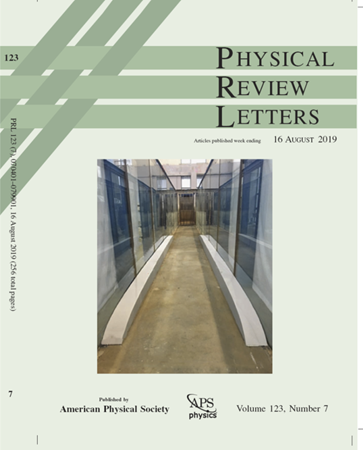Self-Bound Superfluid Membranes and Monolayer Crystals of Ultracold Polar Molecules
IF 9
1区 物理与天体物理
Q1 PHYSICS, MULTIDISCIPLINARY
引用次数: 0
Abstract
We investigate the physics of ultracold dipolar molecules using path-integral quantum Monte Carlo simulations, and construct the complete phase diagram extending from weak to strong interactions and from small to mesoscopic particle numbers. Our calculations predict the formation of self-bound quantum droplets at interaction strengths lower than previous estimates for molecular condensates. Strikingly, we observe that, for stronger interactions, the oblate quantum droplet transitions to a two-dimensional sheet or superfluid membrane with a thickness of a single molecule. As interactions are increased further the system continually loses superfluidity while correlations develop, and is eventually found to undergo a transition to a crystalline monolayer that remains self-bound without external confinement. The spontaneous formation of such two-dimensional phases from a three-dimensional quantum gas is traced back to the peculiar anisotropic form of the dipole-dipole interaction generated by microwave dressing of rotational molecular states. For sufficiently large particle numbers, crystallization takes place for comparably low interaction strengths that do not promote two-body bound states and should thus be observable in ongoing experiments without limitations from three-body recombination.超冷极性分子的自结合超流体膜和单层晶体
我们利用路径积分量子蒙特卡罗模拟研究了超冷偶极分子的物理性质,并构造了从弱相互作用到强相互作用,从小粒子数到介观粒子数的完整相图。我们的计算预测了自束缚量子液滴的形成,其相互作用强度低于先前对分子凝聚物的估计。引人注目的是,我们观察到,对于更强的相互作用,扁圆量子液滴转变为具有单分子厚度的二维薄片或超流体膜。随着相互作用的进一步增加,系统不断失去超流动性,而相关性发展,并最终被发现经历一个过渡到一个没有外部约束的自束缚的晶体单层。这种由三维量子气体自发形成的二维相可以追溯到微波修饰旋转分子态产生的偶极-偶极相互作用的特殊各向异性形式。对于足够大的粒子数,结晶发生在相对较低的相互作用强度下,不会促进两体结合态,因此在正在进行的实验中应该可以观察到,而不受三体重组的限制。
本文章由计算机程序翻译,如有差异,请以英文原文为准。
求助全文
约1分钟内获得全文
求助全文
来源期刊

Physical review letters
物理-物理:综合
CiteScore
16.50
自引率
7.00%
发文量
2673
审稿时长
2.2 months
期刊介绍:
Physical review letters(PRL)covers the full range of applied, fundamental, and interdisciplinary physics research topics:
General physics, including statistical and quantum mechanics and quantum information
Gravitation, astrophysics, and cosmology
Elementary particles and fields
Nuclear physics
Atomic, molecular, and optical physics
Nonlinear dynamics, fluid dynamics, and classical optics
Plasma and beam physics
Condensed matter and materials physics
Polymers, soft matter, biological, climate and interdisciplinary physics, including networks
 求助内容:
求助内容: 应助结果提醒方式:
应助结果提醒方式:


